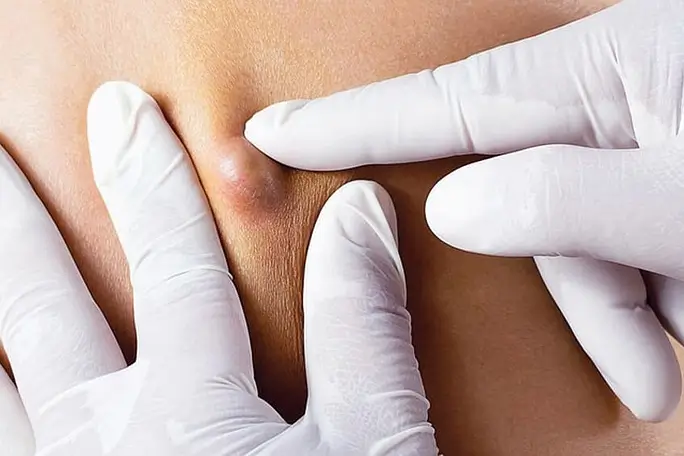Lipomas in New York, NY

Lipomas in New York, NY
Lipomas are benign growths of fat cells which develop just beneath the skin. These soft, round, or oval lumps are usually painless and moveable under the skin when touched. Lipomas are most commonly found on the neck, shoulders, back, abdomen, arms, and thighs, though they can develop almost anywhere on the body. While they generally do not cause harm, lipomas can sometimes grow large enough to become noticeable or uncomfortable, prompting individuals to seek removal for aesthetic or comfort reasons.
What Causes Lipomas?
The exact cause of lipomas is not known, but they are believed to be influenced by a combination of genetic factors and other environmental triggers. Some individuals may have a family history of lipomas, suggesting a hereditary link. Additionally, minor injuries to the skin have been speculated to trigger the formation of lipomas, though this is not definitively proven.
What Are the Different Procedures for Treating Lipomas?
Surgical Removal
Surgical removal is the most common treatment for lipomas, especially if they are large or causing discomfort. The procedure involves making an incision over the lipoma and carefully excising the entire growth. Local anesthesia is typically used, and the client can usually return to normal activities within a few days. Surgical removal is highly effective, with a low risk of recurrence.
Liposuction
Liposuction may be an option for smaller lipomas or those located in areas where a less invasive approach is preferred. A small incision will be made, and a thin tube called a cannula will be inserted to suction out the fatty tissue. This method results in minimal scarring and a quicker recovery time, but it may not be suitable for larger or more complex lipomas.
Steroid Injections
In some cases, steroid injections can be used to shrink lipomas. The steroid solution is directly injected into the lipoma, leading to a reduction in size over time. This approach may be recommended for lipomas that are not suitable for surgical removal or for patients who prefer a non-surgical option. However, this method may not eliminate the lipoma entirely, and the lump could remain palpable.
Radiofrequency Ablation
Radiofrequency ablation involves using high-frequency energy to heat and destroy the lipoma tissue. A needle-like electrode is inserted into the lipoma, delivering energy that breaks down the fat cells. This minimally surgical technique results in less scarring and shorter recovery period than traditional surgery, but may require multiple sessions to achieve the desired results.
What Are the Results of Treating Lipomas?
Treatment of lipomas generally results in the complete removal or significant reduction of the growths. Surgical removal is the most definitive treatment, offering permanent results with a low likelihood of recurrence. Non-surgical methods like liposuction, steroid injections, or radiofrequency ablation may reduce the size of the lipoma but may not completely eliminate it, and there’s a possibility of regrowth. Overall, most patients experience relief from discomfort or aesthetic concerns after treatment.
If you are concerned about a lipoma or if it is causing discomfort or affecting your appearance, Park Plaza Dermatology in New York, NY, offers several effective treatment options. Book an appointment with us to know the best approach for your specific needs.
Benefits of Treating Lipomas
- Improved appearance and skin contour
- Relief from discomfort or pain caused by large lipomas
- Minimal scarring with advanced treatment options
- Quick recovery time for most procedures
- Permanent removal with surgical treatment
- Non-surgical options available
- Low risk of recurrence with proper treatment
- Increased confidence in physical appearance
- Personalized treatment plans
- Professional care from experienced dermatologists
Frequently Asked Questions
No, lipomas are benign tumors, meaning they are not cancerous. They are composed of fat cells and do not spread to other parts of the body. However, it is essential to have any unusual growths evaluated by the dermatologist to rule out other conditions.
While lipomas can occasionally recur after removal, especially if not completely excised, surgical removal typically offers permanent results. Non-surgical treatments may have a higher chance of regrowth, depending on the method used and the individual case.
This condition generally does not require treatment unless they cause discomfort, pain, or cosmetic concerns. Many people choose to have them removed for peace of mind or to improve their appearance. A dermatologist can help you decide if removal is the best option.
Recovery time depends on the treatment method used. Surgical removal may require a few days of rest before returning to normal activities, while less invasive procedures like liposuction or steroid injections typically have a shorter recovery period.
There is no known way to prevent lipomas, as their exact cause is not fully known. However, maintaining a healthy lifestyle and addressing any underlying health conditions may reduce the likelihood of developing multiple lipomas.
Insurance coverage for lipoma removal varies depending on the reason for the procedure. If the removal is deemed medically necessary due to pain, discomfort, or other symptoms, it may be covered. However, cosmetic removal may not be covered by insurance. It’s recommended to check with your provider and discuss coverage options with your dermatologist.
